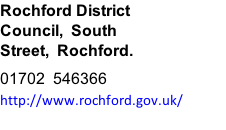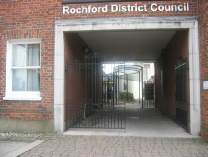







October: Campaign to tackle menace of fly-
This week Love Essex, a partnership of Essex councils and businesses, has re-
Rochford District Council’s Portfolio Holder for the Environment, Cllr Arthur Williams said: “Fly-
During the course of 2017-
There are some easy checks you can carry out to ensure you protect yourself and the environment:
1. If you use a trader to remove your waste ask to see their Waste Carriers Registration Number issued by the Environment Agency
Ask for their waste carrier number and vehicle details and contact the Environment Agency for a free instant waste carrier check.
2. Ensure that you receive a transfer notice or receipt before your waste is taken away
3. Check where your waste is going
Being a registered waste carrier means the person can legally remove your rubbish, but you still need to check what is going to happen to it.
A legitimate waste carrier should not object to you asking these questions.
4. Protect yourself by taking care with your waste
Make a note of who you have given your waste to, their waste carrier details and vehicle details.
You should never leave any waste such as an old washing machine or scrap metal on your drive or in the street for someone to remove. They may not be a registered waste carrier, and could take the bits they need and dump the rest.
You can donate good quality items to your local reuse organisation or charity shop , or give items to someone who could make use of them.
Protect yourself and help keep our county clean and green. Love Essex – it’s a Crime not to care!
Visit loveessex.org for further advice
September: UK’s largest coastal wetland restoration nears completion.
The Wallasea Island Wild Coast project’s restoration of 670 hectares of coastal wetland on the Essex coast will be soon be complete, nearly 10 years after work started.
The creation this year of 269 hectares of new lagoons and marshes on the southern part of the island forms the final piece of the puzzle.
At an event on Friday attended by project partners, funders and stakeholders, local MP Mark Francois put the finishing touches to a new island to mark the final stage of restoration.
Friday 21 September – Nearly 10 years after work to restore 670 hectares of coastal wetland on the Essex coast, the Wallasea Island Wild Coast project – the largest coastal wetland restoration project ever undertaken in the UK – is nearing completion.
Wallasea Island nature reserve is a wetland for the future: designed to offset losses of wildlife rich coastal habitats such as saltmarsh to sea level rises; and to provide habitat to encourage the return of species that historically bred in the UK, such as spoonbills and Kentish plover, as well as new breeding species like black-
At an event MP for Rayleigh and Wickford and long-
Mark Francois MP: “I am delighted to have been invited to help mark the final stage of this fantastic project to restore Essex’s wild coast, having had the opportunity to see the creation of the Wallasea Island Wild Coast unfold over the last decade.
“Managing our landscapes well for nature in the face of wildlife loss and the effects of climate change is a massive challenge. The scale and scope of the Wild Coast project’s ambition in transforming Wallasea Island, not only creating wetland habitats rich in wildlife, but helping adapt the coast to future sea level rises, shows what is possible when people work together to meet this challenge head on.
“I hope the Wild Coast project will inspire other equally ambitious and innovative solutions to address the impacts of climate change in ways that benefit nature. The legacy of the project is sure to live on in Essex in the form of the wildlife that is already starting to make use of the newly created habitats, and the people who are starting to visit the island in larger and larger numbers to enjoy it and access this invaluable addition to Essex’s natural coastal heritage.”
Work to restore the remaining 269 Hectares to the south of the island began Earlier this summer, funded by Viridor Credits and Enovert Community Trust. The creation of three new areas of coastal wetland habitat – 55 hectares of brackish marsh, 82 hectares of freshwater marsh, and 132 hectares of tidal saline lagoon is now in its final stages.
Added to the 399 hectares already restored at Wallasea Island since 2011, the new habitats will complete the UK’s largest coastal wetland restoration, and the largest mosaic of habitats of its kind in Northern Europe.
Work to transform Wallasea Island’s reclaimed arable landscape started nearly 10 years ago with the partnership between Crossrail and the RSPB. 3 million tonnes of material excavated from beneath London in Europe’s largest civil engineering project was transported to the Essex Coast, where it was used to build a new sea wall and create painstakingly landscapes islands and lagoons in what would become Jubilee Marsh.
Just 3 years after the tide was allowed back onto this part of the island for the first time in 400 years, wildlife has already started to return: avocets and ringed plovers, wintering brent geese, and birds of prey including merlins and short-
Plans to extend the reserve’s 9km network of footpaths will open up even more of the island to visitors in the future, providing access to this newly restored part of Essex’s wild coast and natural heritage
Family Theatre Fun Comes To Rayleigh
Rochford District Council present Look a Like Queen Elsa and Santa’s Windmill Grotto, Rayleigh Windmill
Sunday 16th December Performances at 11 am, 12pm, 1pm and 2pm
Running time: 40 minutes
Come and join our Snow Queen inside her magical grotto at Rayleigh Windmill. Where she will read Christmas tale, followed by a special meet and greet. Santa shall also be making a pit stop from making toys to visit the Windmill and give every child who visits a Christmas gift! Come and get into the Christmas Spirit at Rayleigh Windmill.
With tickets costing just £4.50 per person there has never been a better opportunity for some family theatre fun!
To book tickets please ring customer services on 01702 318191.
June 2018: South Essex Councils set out vision for region’s growth
Councils across South Essex have agreed a common approach to supporting the development of housing and key infrastructure over the next twenty years.
The Association of South Essex Local Authorities (ASELA) – which is made up of Basildon, Brentwood, Castle Point, Essex County, Rochford, Southend-
This, along with preparing a Joint Strategic Plan for South Essex would assist future plans for development to ensure new transport links, health and social infrastructure, business and skill opportunities are all included and will ensure that the 90,000 homes that have been identified as being need across south Essex over the next twenty years are built.
Background:
The Government is looking to local authorities to prepare Statements of Common Ground as part of a new Local Plan process, and more specifically, to provide the main evidence to demonstrate that strategic planning matters have been dealt with effectively and the legal provisions of the ‘Duty to Cooperate’ have been met. ASELA have been a national pilot for the new process and are the first collective of local authorities to reach this stage of the new process.
Between the six local authority areas, 4,500 homes need to be built each year over the next 20 years (90,000) to meet Government housing targets.
The Statement of Commons Ground is going through the respective councils democratic process and can be viewed on https://www.castlepoint.gov.uk/agendas-
The Association of South Essex Local Authorities (ASELA) consists of Basildon, Brentwood, Castle Point, Essex County, Rochford, Southend-
All seven councils have recognised the need to work across borders on strategic issues such as infrastructure, planning and growth, skills, housing and transport connectivity. An MoU was signed on 10 January 2018.
The Statement of Common Ground looks at the next steps – including how the joint strategic plan will be put together. After this, the South Essex Spatial Strategy will be published; this will identify areas for growth, infrastructure and housing. It will go out to public engagement in 2019 and is designed to help deliver future growth and local plans.
To make reading and access easier, from the beginning of 2018 we will carry news from RDC one month at a time
